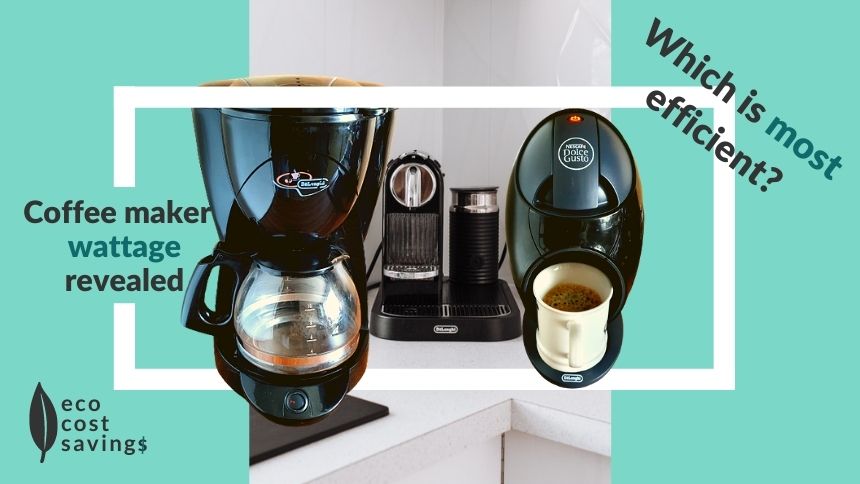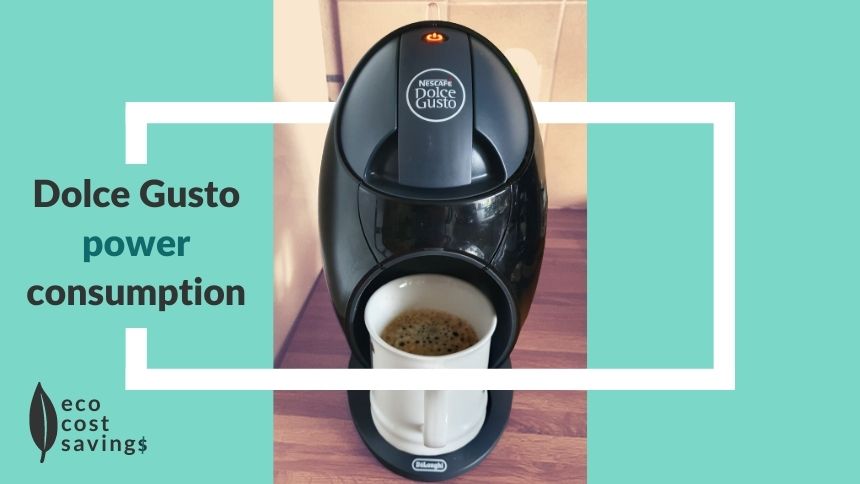Last updated: February 2, 2024.
See the most energy efficient coffee makers, running costs and the average coffee maker wattage based on 117 of the top selling machines in 2024. Also, reduce your running costs easily with these 5 tips.
I researched 117 of the top selling coffee makers.
Here are some of the key results:
- The average wattage of a coffee maker is 1,317W.
- On average in the US, with 1.32 kWh consumed, it costs 20 cents per hour to run a coffee maker at max power.
- Drip coffee makers consume the least amount of electricity per hour on average, followed by single-serve coffee makers. Espresso machines consume most electricity on average.
- Here are the lowest wattage drip, self-serve, espresso and combination coffee makers.
- Electric kettles can be a more efficient option than coffee makers.
Coffee makers are energy guzzlers. Continue reading to get 5 tips to reduce the cost of running your coffee maker, and more.
- Coffee maker wattage
- Coffee maker wattage by machine type
- How much electricity does a coffee maker use (in kWh)
- Cost of running a coffee maker
- Do coffee makers use a lot of electricity?
- Energy efficient coffee makers
- Reduce the cost of running your coffee maker – 5 easy tips
- Coffee maker vs electric kettle
- Coffee maker vs Espresso machine
- Final thoughts

Coffee maker wattage
The average wattage of a coffee maker is 1,317W.
The most common coffee maker wattage is 1,350W.
The highest wattage identified is 2,090W, while the lowest is 650W.
Coffee maker wattage varies by machine and machine type.
Taking Best Buy’s 117 top selling coffee machines in 2024, we can estimate the average wattage of coffee makers along with the average for each machine type.
53% of coffee makers have an above average wattage, with 46% below average.
The following groups the wattage of the 117 devices into low, medium and high ranges.
Low wattage coffee maker
Low wattage coffee makers range from 0W to 1,200W.
30% of the coffee makers in the study fall into the low wattage group.
At 650W, the lowest wattage electric coffee maker identified in 2024 is the Bella Pro Series – 5-Cup Coffee Maker.
Medium wattage coffee maker
Medium wattage coffee makers range from 1,201W to 1,449W.
33% of devices recorded fall into the medium wattage range.
At 1,300W, the De’Longhi – DEDICA Espresso Machine is the closest to average in this range.
High wattage coffee maker
High wattage coffee makers range from 1,450W to 2,090W and above.
37% of the coffee makers in the study fall into the high wattage range.
At 2,090W, the highest wattage home coffee maker recorded is the Nespresso – De’Longhi Expert Espresso Machine.
However, consuming 1,260W, the original model in the series uses a lot less electricity. So, if you’re looking for a similar but less power hungry alternative, check out the Nespresso Expert Original, here.
Coffee maker wattage by machine type
Now that we know the overall average wattage of coffee makers and the low, medium and high wattage ranges, let’s take a look at the wattage by machine type.
Drip coffee maker wattage
The average wattage for drip coffee makers in 2024 is 1,253W.
The most common drip coffee maker wattage is 1,450W.
The lowest wattage coffee maker recorded in the study is a drip coffee maker.
At 650W, the drip coffee maker with the lowest wattage is the Bella Pro Series – 5-Cup Coffee Maker.
The highest wattage recorded in this category is 1,700W.
Single-serve coffee maker wattage
The average wattage for a single-serve coffee maker is 1,282W.
The most common single-serve coffee maker wattage is 1,260W.
At 950W, the single-serve coffee maker with the lowest wattage is the CHEFMAN – InstaCoffee Single Serve K-Cup Pod Coffee Maker.
The highest wattage recorded in this category is 1,500W.
Espresso coffee machine wattage
The average wattage for an Espresso coffee machine is 1,402W.
The most common Espresso coffee machine wattage is 1,450W.
At 750W, the Espresso coffee machine with the lowest wattage is the Bella Pro Series – Pro Series Espresso Machine.
The highest wattage recorded in this category, in 2024, is 1,800W.
Combination coffee maker wattage
The average wattage for a combination coffee maker is 1,368W.
The most common combination coffee maker wattage is 1,350W.
At 800W, the combination coffee maker with the lowest wattage is the Capresso – Steam PRO 4-Cup Coffee Maker and Espresso Machine.
The highest wattage recorded in this category is 2,090W – this is the highest wattage of the 117 coffee makers.
Now that we know the wattage of the different types of coffee makers, let’s take a look at electricity consumed over time.
How much electricity does a coffee maker use (in kWh)
Coffee makers use 1.32 kWh of electricity, on average, per hour (max).
The most common coffee maker consumes 1.35 kWh of electricity per hour (at max), with the lowest and highest consumption being 0.65 kWh and 2.09 kWh, respectively.
Kilowatt-hours (kWh) is a measurement of how much electricity is used over time.
For convenience, I worked out the electricity consumed over 1 hour and assumed max power was being used for the full period. To convert the wattage to kWh (for a 1 hour duration), simply divide by 1,000.
The table below shows how much electricity each coffee maker type consumes over 1 hour at max power consumption.
| Drip Coffee Makers | Single-serve Coffee Makers | Espresso Coffee Machines | Combination Coffee Makers | All Coffee Makers | |
| Average | 1.25 kWh | 1.28 kWh | 1.40 kWh | 1.37 kWh | 1.32 kWh |
| Most common | 1.45 kWh | 1.26 kWh | 1.45 kWh | 1.35 kWh | 1.35 kWh |
| Highest | 1.70 kWh | 1.50 kWh | 1.80 kWh | 2.09 kWh | 2.09 kWh |
| Lowest | 0.65 kWh | 0.95 kWh | 0.75 kWh | 0.80 kWh | 0.65 kWh |
Note: the max wattage won’t be sustained consecutively for the full hour (unless heating and dispensing is fully active the whole time) – it may take several days for your coffee maker to consume 1 hour of electricity at max power consumption. This doesn’t include consumption while idle, heating while idle, etc. – I go into more detail about how much electricity single-serve (more specifically, Dolce Gusto) users can expect to consume, here. Spoiler: it’s 0.03 kWh of electricity per cup.
Now that we know coffee maker power consumption in kWh, it’s simple to work out the running costs.
Cost of running a coffee maker
On average in the US, it costs 20 cents per hour to run a coffee maker at max power.
The most common coffee maker also costs 20 cents per hour (at max) in the US, with the lowest and highest running costs being 10 cents and 31 cents respectively.
To work out your running costs, simply multiply your consumption (in kWh) by the price you pay per kWh.
The table below shows how much it costs to run each coffee maker type for 1 hour at max power consumption, assuming 15c per kWh (the US average).
| Drip Coffee Makers | Single-serve Coffee Makers | Espresso Coffee Machines | Combination Coffee Makers | All Coffee Makers | |
| Average | $0.19 | $0.19 | $0.21 | $0.21 | $0.20 |
| Most common | $0.22 | $0.19 | $0.22 | $0.20 | $0.20 |
| Highest | $0.26 | $0.23 | $0.27 | $0.31 | $0.31 |
| Lowest | $0.10 | $0.14 | $0.11 | $0.12 | $0.10 |
Espresso coffee machines and combination coffee makers are the most expensive to run, on average.
Do coffee makers use a lot of electricity?
Yes.
Coffee makers are considered energy guzzlers.
At 1.32kWh of electricity consumed per hour (at max), the average coffee maker consumes a lot of electricity compared to other household appliances.
Coffee makers, electric heaters and 2HP treadmills use a similar amount of electricity.
The average coffee maker, running for 1 hour, costs roughly the same as the cost of 1 load of laundry.
Household appliances that heat water or air are typically considered energy guzzlers.
But are there any energy efficient coffee makers?
Energy efficient coffee makers
The standout low wattage coffee makers, from the comparison of 117 of Best Buy’s best selling coffee makers, are listed in the table below.
| Coffee Maker Type | Lowest Wattage | Model |
| Drip | 650W | Bella Pro Series – 5-Cup Coffee Maker |
| Self-serve | 950W | CHEFMAN – InstaCoffee Single Serve K-Cup Pod Coffee Maker |
| Espresso | 750W | Bella Pro Series – Pro Series Espresso Machine |
| Combination | 800W | Capresso – Steam PRO 4-Cup Coffee Maker and Espresso Machine |
These are some of the most energy efficient popular household electric coffee makers. DC and some (not all) stove top coffee makers can be more energy efficient. Similarly, it may be more energy efficient for you to use a French Press coffee maker along with a kettle. It all depends on your use case and usage.
So let’s take a look at how you can reduce your running costs and carbon footprint from your coffee machine usage.
Reduce the cost of running your coffee maker – 5 easy tips
- Unplug. Many coffee makers continue to consume electricity when on standby. Unplugging your machine when it’s not in use will stop wastage.
- Only use it when needed. Similar to standby, coffee makers continue to consume electricity when idle and many also heat when idle too. This is convenient when you want to have coffee ready all the time. However, there’s a significant amount of power wastage. Only using your device when needed can help reduce your energy bills and carbon footprint.
- Consider upgrading to a more energy efficient model. Many modern coffee makers have power saving features, such as auto shut off. If you have an older machine, consider upgrading to a more efficient model.
- Reduce temperature. Coffee makers consume most electricity when heating. Reducing the max temperature setting will save energy. If your machine has that feature, why not try it?
- Consider changing energy provider. This is a quick way to reduce your bills without changing habits. Utility providers tend to offer significant discounts to new customers so shop around for better prices. If you want to reduce your carbon footprint, shop around for energy providers that offer green energy plans.
Bonus tips:
Consider gas and a French press. It is usually more cost effective to bring water to a boil using gas. Many factors, such as kettle quality, come into play but given the lower gas prices, it’s generally more cost effective to boil water for coffee using gas. And when combined with a French press and high quality coffee, you can still create an exceptional brew.
Consider using an electric kettle. Depending on the coffee maker and kettle, and how they are used, electric kettles can be a more efficient option. Many variables come into play so let’s compare both of these options next.
Coffee maker vs electric kettle
In terms of the quality of coffee, coffee makers usually deliver high quality coffee instantly. You’ll likely need an additional device, like a French press, to deliver a similar level of coffee quality when using an electric kettle.
However, the cost and environmental impact per coffee tends to be higher for coffee makers as many require coffee pods.
But what about energy consumption?
Like coffee makers, electric kettle wattage varies considerably.
Including energy wastage by overfilling, on average electric kettles consume 0.073 kWh per single use. This is more than double that of a typical single-serve Dolce Gusto coffee maker, which consumes 0.03 kWh per cup.
With electric kettle users typically overfilling by more than 1 cup, it’s slightly more energy efficient to use an electric kettle.
Financially, at less than half a cent, the electricity cost difference per single use for kettles and per cup for the single-serve coffee makers is not substantial.
If you use your coffee maker or electric kettle only when needed, and turn them completely off when not in use, generally speaking (but it really depends on the specific device) a coffee maker will be a more energy efficient option for individual coffee drinkers.
This is primarily due to only heating what is required for each cup of coffee.
However, if you have an efficient kettle and measure just enough water that you need, electric kettles can be a more energy efficient option.
This is because coffee makers tend to heat on idle and consume electricity when on standby. Also, unlike electric kettles, coffee makers consume power when dispensing.
If you’re not vigilant with conserving energy, then chances are that an energy efficient coffee maker will be a more energy efficient option for you. However, due to coffee pods, your overall cost per coffee and your environmental impact will still be higher.
Get more insights into the energy consumption and running costs of a single-serve coffee maker here and electric kettles here.
Coffee maker vs Espresso machine
Espresso machines are one type of coffee maker, but let’s separate them and compare them with other coffee makers.
On average, Espresso machines consume more electricity than other coffee makers.
The average wattage for an Espresso coffee machine is 1,402W, with drip coffee makers averaging 1,253W and single-serve coffee makers averaging 1,282W.
On average, it is less energy efficient to run an Espresso coffee machine compared to other coffee makers. However, there are low wattage options.
Out of the study of 117 coffee makers, the machine with the second lowest wattage is an Espresso machine – the 750W Bella Pro Series – Pro Series Espresso Machine.
So efficient Espresso machines, particularly those that don’t use pods, can potentially have a lower environmental impact than other coffee makers.
Final thoughts
There is no single coffee maker that is the most energy efficient option for everyone. It depends on individual requirements and individual behavior.
The most energy efficient models (in terms of wattage) for each type of coffee maker, identified from the study of 117 coffee makers, are listed above.
I hope the results from the study and the 5 cost saving tips helps you keep your bills and carbon footprint low.
Get more insights into electric kettle power consumption here and single-serve coffee maker running costs here.
Finally, don’t miss this 6 Quick Wins Cheat Sheet – it’ll help you make considerable savings on your energy bills, cost-free:
-
Toaster Wattage 2024 [Lowest W | 226+ Studied | Cost P/Use]
How many watts does a toaster use, & which is the lowest wattage toaster? Find out here, based on enery tests, & a 226+ toaster wattage study. Plus, see the cost per use, hr & more.
-
Coffee Maker Wattage & Efficiency [Top 117 Compared | 2024]
See the most energy efficient coffee makers, running costs & the average coffee maker wattage based on 117 of the top selling machines. Plus, get 5 cost saving tips here.
-
Dolce Gusto power consumption and electricity cost per cup
Every wonder what the electricity cost of a coffee is from a Dolce Gusto? I did. Get a breakdown of the power consumption and electricity cost per cup here.
James F (not to be confused with ECS co-founder James) is our lead author, content & website manager. He has a BSc. in Digital Marketing, and a Diploma in IT. He became a qualified electrician while studying electrical engineering part-time.
From wind and solar photovoltaic installers, James F worked with many certified energy practitioners and energy consultants before joining the core ECS team. He also helped build the most downloaded energy saving app while working with a leading utility company.
Read more about James F or connect directly on LinkedIn, here.


![Toaster Wattage 2024 [Lowest W | 226+ Studied | Cost P/Use]](https://ecocostsavings.com/wp-content/uploads/2022/10/toaster-wattage.jpg)
